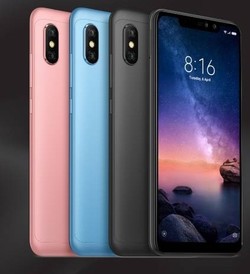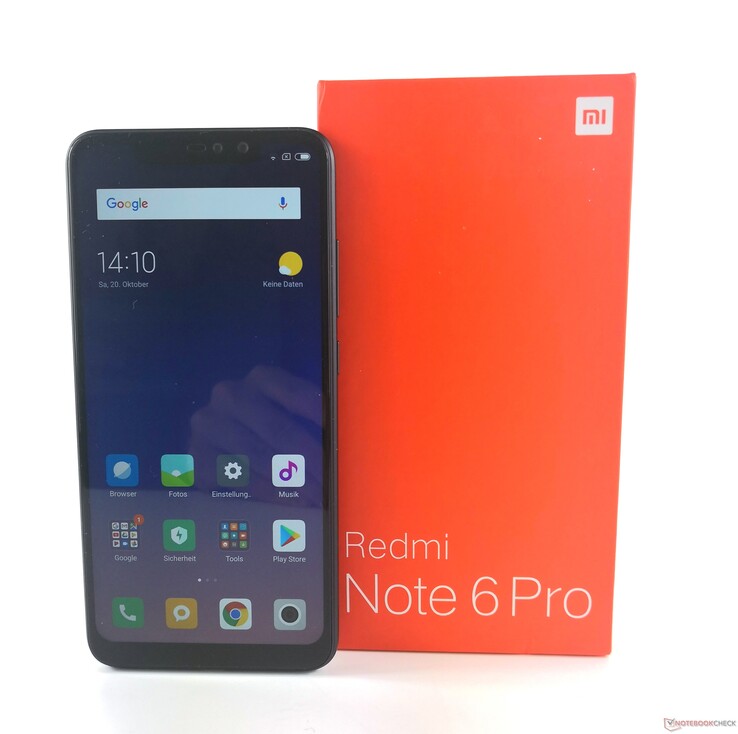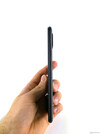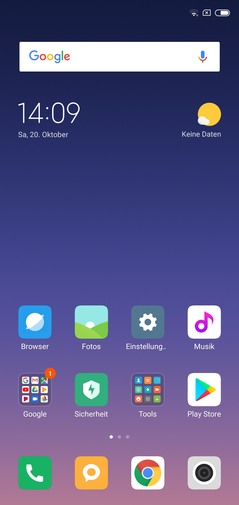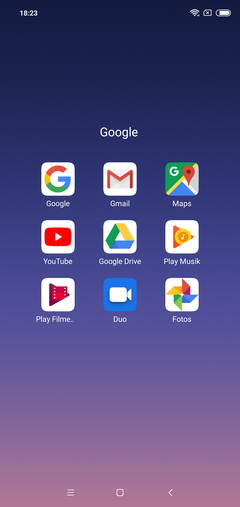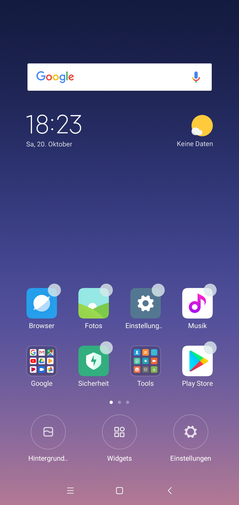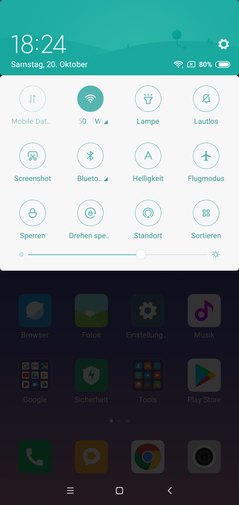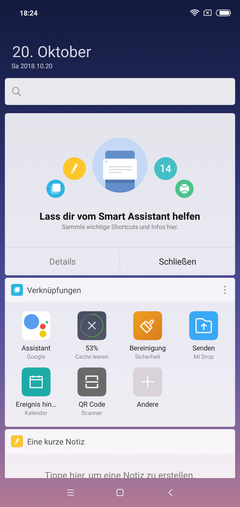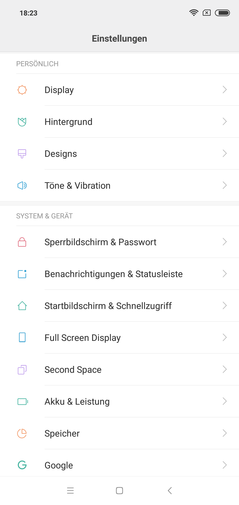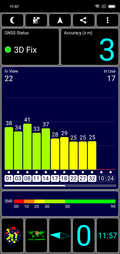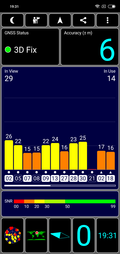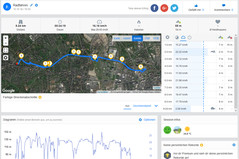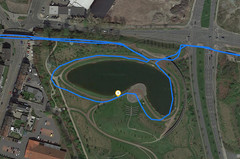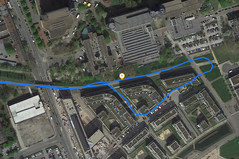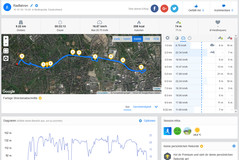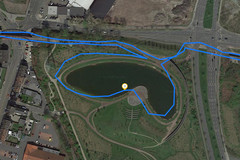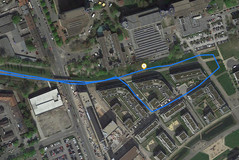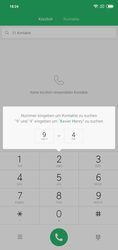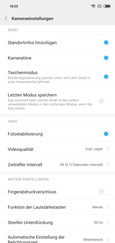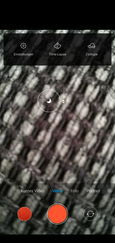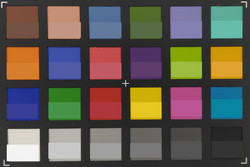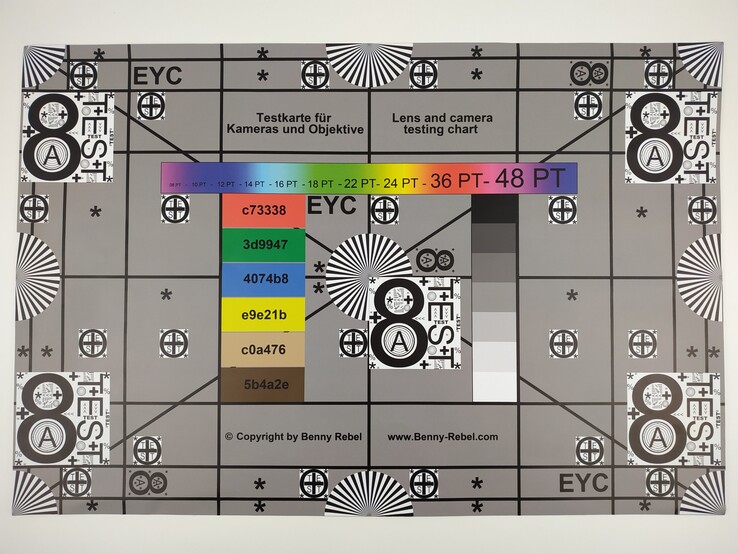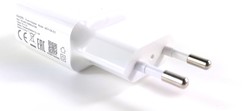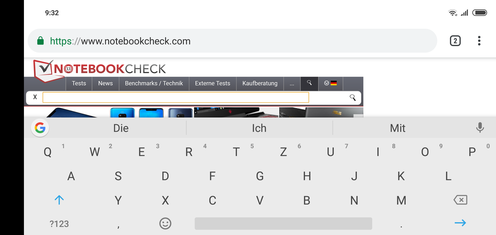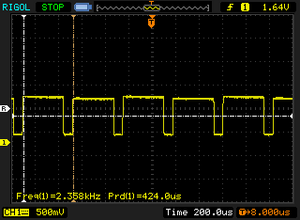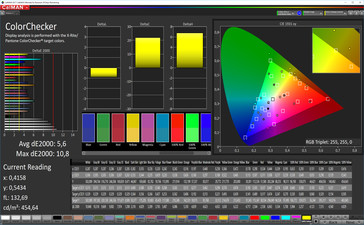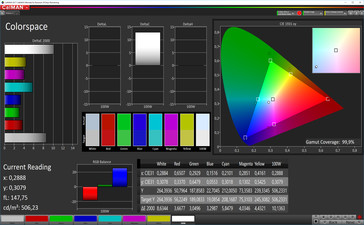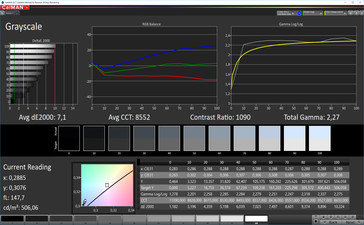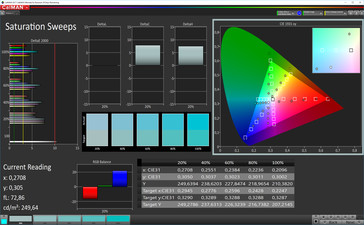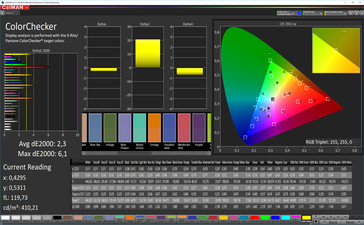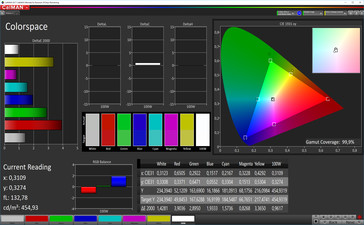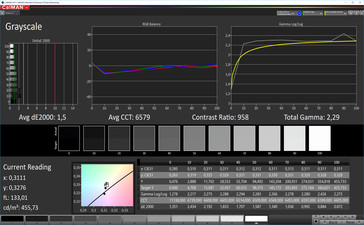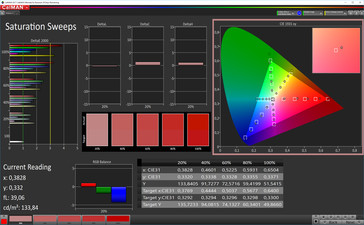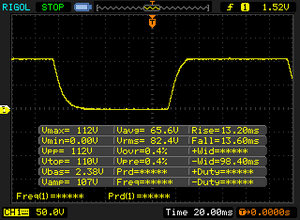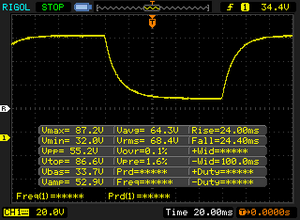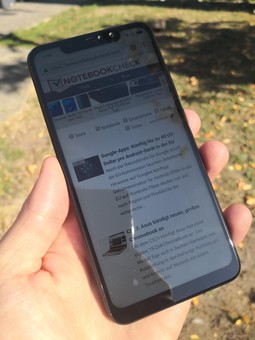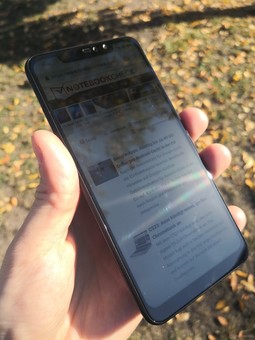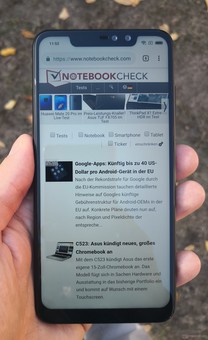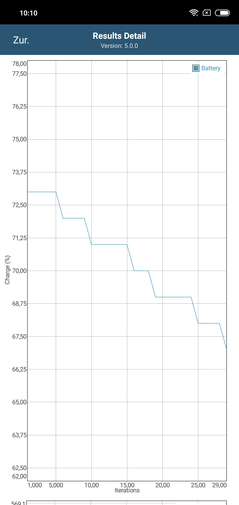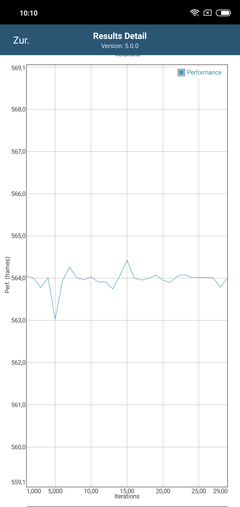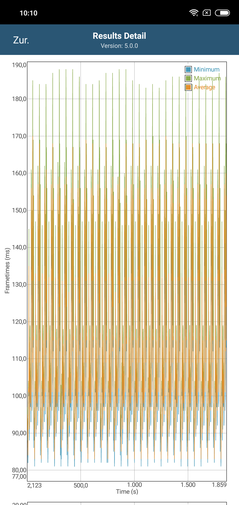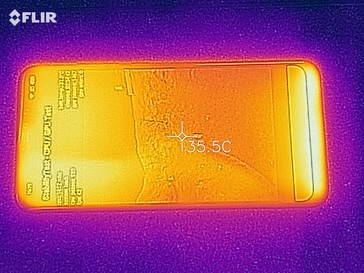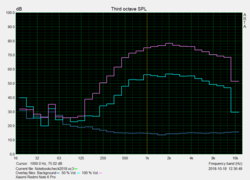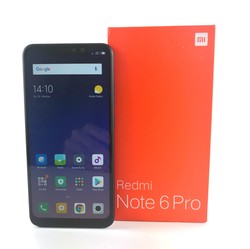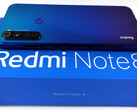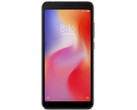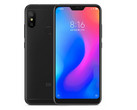Xiaomi Redmi Note 6 Pro Smartphone Review
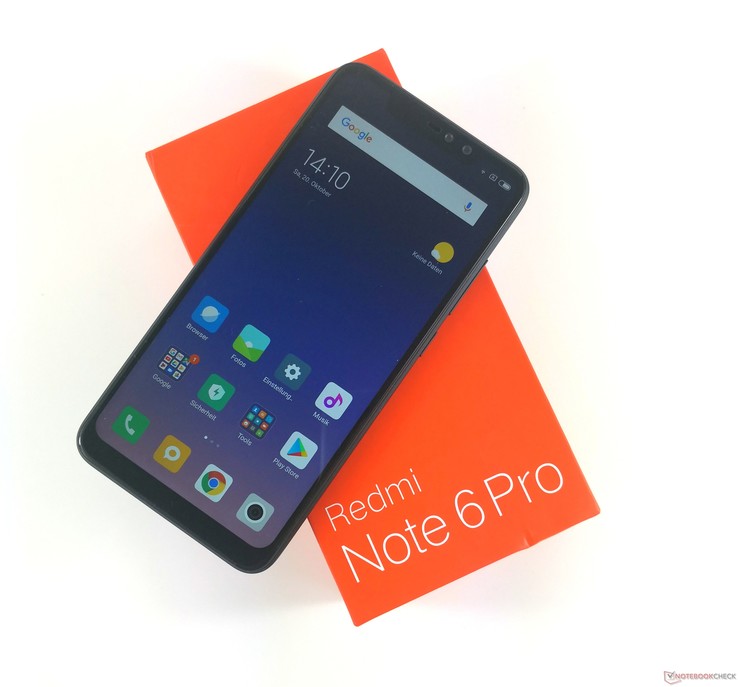
The newest sprout of the Redmi Note series from Xiaomi was introduced to the public at the end of September of this year. The successor to the Redmi Note 5 series belongs to the lower mid-range and offers hardware equipment that is attractive on paper, considering its affordable price. In addition to the Chinese market, at this point the smartphone, which was initially only introduced exclusively via two electronics manufacturers from Thailand, is also available in the European market (EU version) for about 200 Euros (~$228). For the Chinese version, you have to pay about 150 Euros (~$171).
The Redmi Note 6 Pro is able to offer a 6.26-inch IPS panel that has a Full HD+ resolution. Hidden within the notch at the upper display edge is a 20-MP sensor with an f/2.0 aperture as well as a second lens with 2 MP for portrait mode. Another dual-camera unit with 12 and 5 MP sensors is built into the back of the smartphone. Intelligent algorithms of the Xiaomi smartphone are supposed to ensure better image quality via artificial intelligence.
Inside the Redmi Note 6 Pro is a Snapdragon 636 from Qualcomm, which optionally can be supported by either 3 GB of RAM with 32 GB of internal storage or 4 GB of RAM plus 64 GB of ROM. In both model versions, the built-in battery offers a 4000 mAh capacity and can be charged via Quick-Charge technology using the micro-USB port.
Possible competitors of the Xiaomi smartphone used in this test include the current smartphone mid-range: the Nokia 6 (2018), the BQ Aquaris X2, and the Honor 9 Lite. We also add a couple of in-house competitors with the Xiaomi Mi 6X and Xiaomi Redmi 6 Pro that are available at similar prices, and also compare the Redmi Note 6 Pro with its predecessor, the Xiaomi Redmi Note 5.
Case - Xiaomi smartphone with attractive workmanship
Weighing 181 grams (~6.4 oz), the Xiaomi smartphone is available in black, light-blue, or pink color. The front is completely covered by scratch-proof Corning Gorilla Glass that is slightly rounded on the edges. Even though the IPS display has thin bezels around the edges, the chin below the display turned out quite large, so that the screen-to-surface ratio is "only" about 82%, which is less than in the Mi 8 (84%). The haptics of the transition between the plastic frame and the 2.5-D display glass are not ideal, since the glass does not transition smoothly into the frame but is positioned slightly above it, which feels like a bit of an edge in the hands.
The dual-camera unit on the back sticks out significantly from the case. This causes the phone to wobble if it is placed on a table and you touch its sides. Thanks to the matte aluminum finish, the Redmi Note 6 Pro does not particularly attract fingerprints.
The quality of the keys for the volume and power is convincing in our test unit. The keys sit tightly in their frames, and the pressure points are well-defined. The stability of the case is outstanding.
Equipment - Redmi Note 6 Pro with VoLTE
In addition to a notification LED, the equipment of the Redmi Note 6 Pro includes an infrared transmitter, a 3.5-mm audio port, and a fingerprint sensor. You can also wirelessly transfer the display content to external monitors via Miracast. The mid-range smartphone supports Voice over LTE (VoLTE) as well, which allows making phone calls using the 4G net. You can also find Wi-Fi calling in the Settings menu, allowing you to make calls via WLAN, although the Vodafone SIM card we used for our testing does not allow us to activate it.
The USB port is of the micro-USB type with a USB-2.0 connection behind it, allowing you to charge the device. In addition it offers USB-OTG, recognizing external storage media or input devices.
In our test unit, the internal eMMC storage has a capacity of 32 GB, leaving only 22 GB for the user in the state of delivery. You can also expand the internal storage by using a microSD card, as long as you don't need the dual-SIM functionality. The integrated microSD slot can handle the current SDHC and SDXC standards and supports the exFAT file system, but you cannot use microSD cards as internal storage.
Software - MIUI (still) on version 9
At the time of our testing, the operating system installed on the Redmi Note 6 Pro is fairly current with version 8.1 of Google's Android Oreo. To a limited extent, the same also goes for the security patch level of July 2018. On top of the Android interface, the manufacturer has added its in-house MIUI version 9.6 (stable) surface that we already know from our tests of the Xiaomi Mi 6X and Redmi 6 Pro.
An update to the newest MIUI 10 software is currently being distributed to the predecessor, so that this MIUI iteration will probably also arrive soon on the Redmi Note 6 Pro. However, we were still unable to find out about a time frame for the update.
The Mi user-interface includes a lot of adjustments that have only little in common with stock Android. Besides the visual adjustments, the system software offers numerous additional changes. In addition, you can create two completely separate work spaces with the menu item "second space" on the Xiaomi smartphone. For example, one could be for applications used for work and the other for applications used at home.
In our EU version of the Redmi Note 6 Pro, the Google services such as the Play Store and Google apps such as Gmail are already preinstalled. In the state of delivery, a device designed for the Chinese market will only support Chinese and Xiaomi's own services and only include English in addition to Chinese as system language.
Note: If you install the Google Play Store later, possibly some apps such as Netflix cannot be installed, since the Play Store has not been officially certified for the smartphone.
Communication and GPS - Redmi Note 6 Pro with fast ac-WLAN
In terms of communication modules, Xiaomi uses Bluetooth version 5.0. There is no NFC chip for near field communication, so you cannot use Google Pay to pay with the Xiaomi smartphone.
The integrated WLAN module of the Redmi Note 6 Pro supports the IEEE-802.11 a/b/g/n/ac standards and correspondingly not only communicates in the 2.4-GHz but also the 5-GHz frequency range. During everyday use, the reception performance of the WLAN module is good and the signal is stable. However, the Redmi Note 6 Pro does not have the same WLAN range as the Xiaomi Mi 6X. In close proximity to the router (Telekom Speedport, W921V) we measure a dampening of -34 dBm.
In combination with our Linksys EA8500 reference router, the Xiaomi smartphone achieves good transfer rates of 354 Mb/s and 272 Mb/s. This allows the Redmi Note 6 Pro to keep up with the best of the comparison devices in our test.
Thanks to LTE Cat. 6, the dual-SIM smartphone can access the mobile Internet at up to 300 Mb/s in download rates. Xiaomi states that in the EU, only dual-band GSM and dual-band UMTS, as well as access of seven LTE bands, is supported. However, the built-in mobile modem covers almost all the LTE frequencies that are relevant in Germany, and you can use all of them except for LTE bands 28 and 32. The dual-SIM device offers space for two nano-SIM cards, as long as you don't use a storage card. Neither of the two card slots is limited in terms of the frequencies.
The Redmi Note 6 Pro can use the main satellite systems GPS, GLONASS, and Beidou to locate our position. Outdoors, our location is determined quickly with an accuracy of about three meters, and even indoors the position can be located very quickly with an accuracy of up to six meters with the Xiaomi smartphone.
In order to realistically evaluate the accuracy of our test unit, we record a route in parallel with the Garmin Edge 500 GPS bicycle computer and our smartphone for comparison. At the end of our almost 9-km test route (~5.6 miles), there is only a 20-meter difference in the recordings of the affordable mid-range smartphone and the professional navigation device.
The deviations of the GPS module are small, and if you look at the detailed route of the GPS recording, you can see that the Redmi Note 6 Pro is well-suited for navigation in the car with its location accuracy that is to a large extent convincing.
Telephone Functions and Voice Quality - Inconspicuous Xiaomi smartphone
The voice quality is good and inconspicuous during everyday usage. There were no annoying drops or reception problems during our testing.
Voices are reproduced clearly, and we consider the quality of the built-in microphone satisfactory. Our conversation partner also characterizes the reproduction of our voice as clear.
We test the voice quality of the built-in microphone by making phone calls with the Skype app. There is hardly any distortion of our voices, and our conversation partners also label the voice quality as good.
Cameras - Redmi Note 6 Pro with dual-camera system in front and back
The main camera in the back of the Redmi Note 6 Pro has a Samsung image sensor with a resolution of 12 MP in the 4:3 format (4000x3000 pixels). The pixels in the S5K2L7 sensor from the Korean manufacturer have a 1.4-μm edge size. The camera module also has a light-sensitive aperture of f/1.9 and a dual-pixel auto-focus. However, it lacks the OIS for image stabilization.
The second camera in the back has a resolution of 5 MP and collects depth information for the portrait mode. The Samsung S5K5E8 image sensor only has an f/2.0 aperture and 1.12-µm pixel size. The dual camera unit in the back records videos in a Full HD maximum resolution at 30 FPS.
In bright light conditions, the camera unit ensures sharp images that are rich in detail. The dynamic range of the photos is sufficiently large, and the reproduced colors also appear natural and not pale. However, light areas are slightly overexposed.
Despite its wide aperture of f/1.9, the Redmi smartphone is unable to really convince us when recording in the dark. As to be expected in this price range, while the absolute brightness in the recordings is not bad, the contrast and image focus are not optimal, and the images are characterized by strong graininess.
The image sensors in front have a resolution of 20 MP and 2 MP. If there is sufficient light, you can create selfies of a good quality with the Redmi Note 6 Pro. But even if there is little light, the shots are still sufficiently bright. This is possible with a process called pixel-binning, where four pixels are combined into a super-pixel with an effective pixel size of 1.8 μm.
Thanks to the second lens, you can create Bokeh effects that blur the background. The results are surprisingly good and are able to continue the good photo quality of the camera in the back. The front camera can record videos in Full HD resolution (1920x1080 pixels) at up to 30 frames per second.
We evaluate additional criteria for the Redmi Note 6 Pro camera under controlled light conditions. Using the ColorChecker Passport, we analyze the color reproduction of the dual camera unit in the back. At the bottom of each color field is the original color for reference. The colors are fairly accurate but are significantly darker and more saturated. The white balance in the recordings is too warm.
We analyze the image sharpness by reproducing a test chart. Towards the edges, the sharpness drops visibly, but details in the center are well defined. The color transitions are reproduced cleanly, and letters on a dark background are only slightly frayed.
Accessories and Warranty - A Redmi Note 6 Pro case is included
In addition to the Redmi Note 6 Pro, the box includes a short manual, a modular charger (EU) rated at 10 watts (5 V, 2 A), a USB charging cable, and a silicone case.
Xiaomi offers a warranty of 12 months for its smartphones. Please see our Guarantees, Return policies and Warranties FAQ for country-specific information.
Input Devices and Operation - Xiaomi smartphone with an accurate multi-touchscreen
The smartphone is operated either via the Android on-screen keys for "Back," "Home," and "Multi-tasking" or via gesture control as you also find in the Xiaomi Redmi 6 Pro, for example. With a short swipe on the bottom edge of the screen, you can get to the Home screen. If you keep your finger on the display after swiping up, you can get to the running applications. For a step back with the Redmi smartphone, a short swipe from the right or left display edge towards the center is sufficient. Xiaomi uses Google's stock Android solution, the Gboard, as the default virtual keyboard.
The capacitive touchscreen of the Redmi Note 6 Pro is very sensitive. It can be operated accurately up to the edges and has a surface that allows the fingers to glide easily. On the back of the Xiaomi smartphone is a fingerprint sensor. While this can reliably unlock the mid-range model from the Chinese manufacturer, it is not one of the fastest sensors on the market.
Biometric identification via face recognition is also offered – at least in some particular regions. The face-unlock function via the front camera reliably unlocks the Redmi smartphone even in bad light conditions – only not in Germany, if you select that as home country. Like in the Mi 8, the face-unlock function is not available in the Settings for a German user. It only becomes available if you select a different region such as India or France.
Display - IPS panel at high-end smartphone level
Like the predecessor, the IPS display of the Redmi Note 6 Pro offers a Full HD+ resolution, but now it has a resolution of 2280x1080 pixels in a diagonal of 6.26 inches and a 16:9 display format. The resulting pixel density of about 400 ppi remains the same. Whether you would rather need a WAHD resolution (2560x1440 pixels) in a smartphone of this display size is a matter of taste. In our opinion, the content is displayed sufficiently sharp here.
The panel is bright at a 511 cd/m² maximum and the brightness is very evenly distributed at 88%. If the surrounding light sensor is activated, the brightness only changes minimally. In our more realistic APL50 measurement, which simulates an even distribution of bright and dark areas on the IPS panel, it is 516 cd/m² as well.
The Redmi smartphone uses pulse width modulation (PWM) for brightness control, but it is only active at low brightness settings. We were able to measure screen flickering of a quite high frequency of 2358 Hz at a brightness level below 19%.
| |||||||||||||||||||||||||
Brightness Distribution: 88 %
Center on Battery: 501 cd/m²
Contrast: 1139:1 (Black: 0.44 cd/m²)
ΔE Color 2.3 | 0.5-29.43 Ø5
ΔE Greyscale 1.5 | 0.57-98 Ø5.3
99.9% sRGB (Calman 2D)
Gamma: 2.29
| Xiaomi Redmi Note 6 Pro LCD IPS, 2280x1080, 6.26 | Xiaomi Redmi Note 5 IPS, 2160x1080, 5.99 | Xiaomi Redmi 6 Pro LCD IPS, 2280x1080, 5.84 | Xiaomi Mi 6X LCD IPS, 2160x1080, 5.99 | Honor 9 Lite IPS, 2160x1080, 5.65 | Nokia 6 2018 IPS, 1920x1080, 5.50 | BQ Aquaris X2 IPS LCD, 2160x1080, 5.65 | Huawei Mate 20 Pro OLED, 3120x1440, 6.30 | |
|---|---|---|---|---|---|---|---|---|
| Screen | -50% | -55% | -81% | -33% | -91% | -55% | 19% | |
| Brightness middle | 501 | 518 3% | 554 11% | 459 -8% | 627 25% | 417 -17% | 631 26% | 576 15% |
| Brightness | 486 | 532 9% | 538 11% | 441 -9% | 622 28% | 421 -13% | 622 28% | 582 20% |
| Brightness Distribution | 88 | 94 7% | 91 3% | 91 3% | 82 -7% | 88 0% | 96 9% | 90 2% |
| Black Level * | 0.44 | 0.23 48% | 0.61 -39% | 0.47 -7% | 0.41 7% | 0.61 -39% | 0.61 -39% | |
| Contrast | 1139 | 2252 98% | 908 -20% | 977 -14% | 1529 34% | 684 -40% | 1034 -9% | |
| Colorchecker dE 2000 * | 2.3 | 5.66 -146% | 4.86 -111% | 5.8 -152% | 4.5 -96% | 6.1 -165% | 5.5 -139% | 1.3 43% |
| Colorchecker dE 2000 max. * | 6.1 | 10.32 -69% | 8.46 -39% | 10.7 -75% | 7 -15% | 11.2 -84% | 8.5 -39% | 3.5 43% |
| Greyscale dE 2000 * | 1.5 | 6.8 -353% | 5.3 -253% | 7.3 -387% | 5.1 -240% | 7.1 -373% | 5.6 -273% | 1.6 -7% |
| Gamma | 2.29 96% | 2.269 97% | 2.281 96% | 2.28 96% | 2.26 97% | 2.16 102% | 2.38 92% | 2.18 101% |
| CCT | 6579 99% | 8564 76% | 7770 84% | 7984 81% | 7201 90% | 8362 78% | 7531 86% | 6561 99% |
* ... smaller is better
Screen Flickering / PWM (Pulse-Width Modulation)
| Screen flickering / PWM detected | 2358 Hz | ≤ 19 % brightness setting | |
The display backlight flickers at 2358 Hz (worst case, e.g., utilizing PWM) Flickering detected at a brightness setting of 19 % and below. There should be no flickering or PWM above this brightness setting. The frequency of 2358 Hz is quite high, so most users sensitive to PWM should not notice any flickering. In comparison: 53 % of all tested devices do not use PWM to dim the display. If PWM was detected, an average of 17903 (minimum: 5 - maximum: 3846000) Hz was measured. | |||
When displaying absolute black, which ensures excellent contrast, the Redmi Note 6 Pro could still be better. We measure a black value of 0.44 cd/m². In combination with the display brightness, this results in a good contrast ratio of more than 1:1000. Our APL-50 measurement results in a slightly low contrast (1:1221), since the black value is slightly worse (0.46 cd/m²) with evenly distributed light and dark areas.
We evaluate the accuracy of the color reproduction with a photo spectrometer and the CalMAN analysis software. By default, the "Automatic" contrast and "Standard" color temperature profile values are activated. This automatically selects the best settings, depending on the content displayed. There are additional color profiles you can select (Warm, Cool), as well as two additional options to adjust the contrast (Standard, Increased Contrast).
The Redmi Note 6 Pro has a color accuracy that is outstanding for this price range. In the "Warm" color profile, the Delta-E deviations for mixed colors are very low. The Grayscale is also reproduced accurately and there is no color tint. The sRGB color space is almost completely covered.
Display Response Times
| ↔ Response Time Black to White | ||
|---|---|---|
| 26.8 ms ... rise ↗ and fall ↘ combined | ↗ 13.2 ms rise | |
| ↘ 13.6 ms fall | ||
| The screen shows relatively slow response rates in our tests and may be too slow for gamers. In comparison, all tested devices range from 0.1 (minimum) to 240 (maximum) ms. » 62 % of all devices are better. This means that the measured response time is worse than the average of all tested devices (21.5 ms). | ||
| ↔ Response Time 50% Grey to 80% Grey | ||
| 48.4 ms ... rise ↗ and fall ↘ combined | ↗ 24 ms rise | |
| ↘ 24.4 ms fall | ||
| The screen shows slow response rates in our tests and will be unsatisfactory for gamers. In comparison, all tested devices range from 0.2 (minimum) to 636 (maximum) ms. » 82 % of all devices are better. This means that the measured response time is worse than the average of all tested devices (33.7 ms). | ||
Performance - Snapdragon 636 with power reserves
The Qualcomm Snapdragon 636 is a mid-range SoC that possesses eight processor cores based on its own Kryo-260 architecture. The 64-bit capable processor is manufactured using the 14-nm FinFET process and integrates an Adreno 509 graphics card, which is also positioned in the mid-range.
In everyday operation, the system performance is mostly smooth. Under MIUI 9, animations are not always free from stutters but are choppy, particularly when using gesture control. We already saw similar problems (in weaker form) in the Mi 8 with the "old" user interface. However, that performed a lot better with MIUI 10. In addition, there are the typical delays of a mid-range SoC during multi-tasking, and the load times become longer.
The performance in the synthetic benchmarks ranges on the level of a BQ Aquaris X2 with stock Android and the same Snapdragon 636 SoC built-in. The integrated Adreno graphics unit does not show any weaknesses in our graphics-heavy tests.
| Basemark GPU 1.1 | |
| 1920x1080 Vulkan Medium Offscreen (sort by value) | |
| Huawei Mate 20 Pro | |
| Vulkan Medium Native (sort by value) | |
| Xiaomi Mi 6X | |
| BQ Aquaris X2 | |
| Huawei Mate 20 Pro | |
| Average Qualcomm Snapdragon 636 () | |
| 1920x1080 OpenGL Medium Offscreen (sort by value) | |
| Xiaomi Mi 6X | |
| BQ Aquaris X2 | |
| Huawei Mate 20 Pro | |
| Average Qualcomm Snapdragon 636 () | |
Surfing with the Chrome browser does not offer much reason for complaint. The Redmi Note 6 Pro ranges in the front of the comparison field in all the benchmarks, and in practice the Xiaomi smartphone can score with quite high speeds while surfing. Loading of complex page content can take a bit longer at times.
| JetStream 1.1 - Total Score | |
| Huawei Mate 20 Pro (Chrome 69) | |
| Average of class Smartphone (last 2 years) | |
| Xiaomi Mi 6X (Chrome 67) | |
| Average Qualcomm Snapdragon 636 (44.2 - 51.5, n=11) | |
| Xiaomi Redmi Note 6 Pro (Chrome 70) | |
| Xiaomi Redmi Note 5 (Chrome 67) | |
| BQ Aquaris X2 (Chrome 67) | |
| Nokia 6 2018 (Browser: Chrome 65) | |
| Honor 9 Lite (Chrome 63) | |
| Xiaomi Redmi 6 Pro (Chrome 68) | |
| Octane V2 - Total Score | |
| Average of class Smartphone (2228 - 89112, n=214, last 2 years) | |
| Huawei Mate 20 Pro (Chrome 69) | |
| Xiaomi Mi 6X (Chrome 67) | |
| BQ Aquaris X2 (Chrome 67) | |
| Average Qualcomm Snapdragon 636 (8163 - 9746, n=12) | |
| Xiaomi Redmi Note 5 (Chrome 67) | |
| Xiaomi Redmi Note 6 Pro (Chrome 70) | |
| Nokia 6 2018 (Browser: Chrome 65) | |
| Xiaomi Redmi 6 Pro (Chrome 68) | |
| Honor 9 Lite (Chrome 63) | |
| Mozilla Kraken 1.1 - Total | |
| Honor 9 Lite (Chrome 63) | |
| Nokia 6 2018 (Browser: Chrome 65) | |
| Xiaomi Redmi 6 Pro (Chrome 68) | |
| Xiaomi Mi 6X (Chrome 67) | |
| Xiaomi Redmi Note 6 Pro (Chrome 70) | |
| Xiaomi Redmi Note 5 (Chrome 67) | |
| BQ Aquaris X2 | |
| Average Qualcomm Snapdragon 636 (4105 - 5066, n=12) | |
| Huawei Mate 20 Pro (Chrome 69) | |
| Average of class Smartphone (388 - 9999, n=173, last 2 years) | |
| WebXPRT 3 - Overall | |
| Average of class Smartphone (39 - 304, n=122, last 2 years) | |
| Huawei Mate 20 Pro (Chrome 69) | |
| Xiaomi Mi 6X (Chrome 67) | |
| Xiaomi Redmi Note 5 (Chrome 66) | |
| Xiaomi Redmi Note 6 Pro (Chrome 70) | |
| Average Qualcomm Snapdragon 636 (46 - 61, n=9) | |
| BQ Aquaris X2 (Chrome 67) | |
| Xiaomi Redmi 6 Pro (Chrome 68) | |
| Nokia 6 2018 (Chrome 66) | |
| WebXPRT 2015 - Overall | |
| Huawei Mate 20 Pro (Chrome 69) | |
| Xiaomi Mi 6X (Chrome 67) | |
| BQ Aquaris X2 (Chrome 67) | |
| Xiaomi Redmi Note 5 (Chrome 67) | |
| Average Qualcomm Snapdragon 636 (147 - 184, n=8) | |
| Xiaomi Redmi Note 6 Pro (Chrome 70) | |
| Nokia 6 2018 | |
| Xiaomi Redmi 6 Pro (Chrome 68) | |
| Honor 9 Lite (Chrome 63) | |
* ... smaller is better
The speed of the 32 GB internal eMMC storage is excellent considering the storage type, and the speed of the microSD card reader is also able to convince. While the transfer rates are very decent, they do not surpass those of the competitors. The Redmi Note 6 Pro is unable to use the capabilities of our Toshiba Exceria Pro M501 reference card to the full extent.
| Xiaomi Redmi Note 6 Pro | Xiaomi Redmi Note 5 | Xiaomi Redmi 6 Pro | Xiaomi Mi 6X | Honor 9 Lite | Nokia 6 2018 | BQ Aquaris X2 | Huawei Mate 20 Pro | Average 32 GB eMMC Flash | Average of class Smartphone | |
|---|---|---|---|---|---|---|---|---|---|---|
| AndroBench 3-5 | -15% | 18% | 3% | 8% | -19% | -8% | 100% | -25% | 481% | |
| Sequential Read 256KB | 278.9 | 287.6 3% | 278.7 0% | 272 -2% | 269.6 -3% | 272.6 -2% | 270.5 -3% | 853 206% | 242 ? -13% | 1508 ? 441% |
| Sequential Write 256KB | 119.9 | 121.6 1% | 212.9 78% | 203.7 70% | 138.2 15% | 118.3 -1% | 188.7 57% | 196.4 64% | 100.5 ? -16% | 1118 ? 832% |
| Random Read 4KB | 55.5 | 48.9 -12% | 66.9 21% | 73 32% | 68.4 23% | 38.78 -30% | 43.9 -21% | 157.4 184% | 43.2 ? -22% | 247 ? 345% |
| Random Write 4KB | 67.3 | 16.3 -76% | 72.6 8% | 6.89 -90% | 66.8 -1% | 15.3 -77% | 14.4 -79% | 157.8 134% | 22.4 ? -67% | 272 ? 304% |
| Sequential Read 256KB SDCard | 83.9 ? | 83.4 -1% | 83.5 ? 0% | 83.1 ? -1% | 83.4 ? -1% | 82.9 ? -1% | 83.2 ? -1% | 71.8 ? -14% | ||
| Sequential Write 256KB SDCard | 63.7 ? | 62.4 -2% | 62.2 ? -2% | 71.9 ? 13% | 61.3 ? -4% | 62.3 ? -2% | 72.4 ? 14% | 52.9 ? -17% |
Games - You have to lower your sights with the Adreno 509
The Qualcomm Adreno 509 supports all the modern APIs such as Vulkan, OpenGL ES 3.1 + AE (3.2), and Direct3D 12. In order to evaluate the 3D performance of the Redmi Note 6 Pro, we take a closer look at a couple of demanding games from the Play Store with the GameBench app.
At the highest display quality, graphics-heavy games that are not quite current anymore, such as the Dead Trigger 2 ego-shooter, are displayed consistently at a high 60 FPS. Current and therefore graphically more-demanding games such as PUBG Mobile are not really smoothly playable anymore. You can see drops in the frame refresh rate in short intervals even at the lowest graphics settings.
The sensors and the touchscreen respond without fault in the test.
Dead Trigger 2
Emissions - The Redmi Note 6 Pro remains cool
Temperature
Neither the back nor the front show much warming during load. We measure a maximum of barely 35 °C (95 °F) on the front during the test, and the back also shows a very low maximum surface temperature of barely 33 °C (91 °F). In everyday operation, the temperature development of the Redmi Note 6 Pro does not pose any problems or hindrances.
Using the ES3.1 battery test of GFXBench, we test whether the Snapdragon 636 throttles under computing-intensive loads. The same sequence is rendered 30 times in a row, and the values achieved are recorded. The results of the Xiaomi smartphone show that the frame rate varies very little, with the variations remaining within a range below one percentage point. This shows that performance drops under load are very unlikely.
(+) The maximum temperature on the upper side is 34.5 °C / 94 F, compared to the average of 35 °C / 95 F, ranging from 21.9 to 56 °C for the class Smartphone.
(+) The bottom heats up to a maximum of 32.8 °C / 91 F, compared to the average of 33.8 °C / 93 F
(+) In idle usage, the average temperature for the upper side is 24.4 °C / 76 F, compared to the device average of 32.7 °C / 91 F.
Speaker
For playing music, there is a mono speaker at the bottom of the smartphone case. The quality of the speaker is satisfactory and corresponds to the price range.
The speaker in the Redmi Note 6 Pro reproduces sounds fairly linear in the mid-range, but very high tones drop at about 15 kHz. At 87 dB(A), the maximum volume is sufficiently loud. If you don't crank the volume all the way up, you are offered a decent sound.
You can also output audio via the 3.5-mm audio port, which subjectively delivers a loud and clear sound output with little noise.
Xiaomi Redmi Note 6 Pro audio analysis
(+) | speakers can play relatively loud (86.9 dB)
Bass 100 - 315 Hz
(-) | nearly no bass - on average 30.2% lower than median
(±) | linearity of bass is average (8.9% delta to prev. frequency)
Mids 400 - 2000 Hz
(±) | higher mids - on average 5% higher than median
(+) | mids are linear (5.2% delta to prev. frequency)
Highs 2 - 16 kHz
(+) | balanced highs - only 3.5% away from median
(+) | highs are linear (2.3% delta to prev. frequency)
Overall 100 - 16.000 Hz
(±) | linearity of overall sound is average (20.7% difference to median)
Compared to same class
» 30% of all tested devices in this class were better, 9% similar, 61% worse
» The best had a delta of 12%, average was 38%, worst was 134%
Compared to all devices tested
» 50% of all tested devices were better, 8% similar, 42% worse
» The best had a delta of 4%, average was 25%, worst was 134%
Xiaomi Redmi 6 Pro audio analysis
(±) | speaker loudness is average but good (81.1 dB)
Bass 100 - 315 Hz
(-) | nearly no bass - on average 63.6% lower than median
(+) | bass is linear (0% delta to prev. frequency)
Mids 400 - 2000 Hz
(-) | nearly no mids - on average 63.6% lower than median
(+) | mids are linear (0% delta to prev. frequency)
Highs 2 - 16 kHz
(-) | nearly no highs - on average 63.6% lower than median
(+) | highs are linear (0% delta to prev. frequency)
Overall 100 - 16.000 Hz
(-) | overall sound is not linear (121.6% difference to median)
Compared to same class
» 89% of all tested devices in this class were better, 9% similar, 2% worse
» The best had a delta of 12%, average was 38%, worst was 134%
Compared to all devices tested
» 96% of all tested devices were better, 3% similar, 1% worse
» The best had a delta of 4%, average was 25%, worst was 134%
Battery Life - The Redmi Note 6 Pro offers a good battery life
Power Consumption
While the power consumption of the Xiaomi smartphone is slightly high during idle, it is able to convince under load, where the Redmi 6 Note Pro remains below the Qualcomm Snapdragon 636 competitors.
Using the included 10-watt charger, the battery can be fully recharged within about 2.5 hours.
| Off / Standby | |
| Idle | |
| Load |
|
| Xiaomi Redmi Note 6 Pro 4000 mAh | Xiaomi Redmi Note 5 4000 mAh | Xiaomi Redmi 6 Pro 4000 mAh | Xiaomi Mi 6X 3010 mAh | Honor 9 Lite 3000 mAh | Nokia 6 2018 3000 mAh | BQ Aquaris X2 3100 mAh | Huawei Mate 20 Pro 4200 mAh | Average Qualcomm Snapdragon 636 | Average of class Smartphone | |
|---|---|---|---|---|---|---|---|---|---|---|
| Power Consumption | -15% | -13% | 13% | 19% | 30% | 9% | 4% | -4% | 1% | |
| Idle Minimum * | 1.12 | 1 11% | 1.3 -16% | 0.65 42% | 0.85 24% | 0.67 40% | 0.65 42% | 0.95 15% | 0.944 ? 16% | 0.897 ? 20% |
| Idle Average * | 2.62 | 2.6 1% | 2.1 20% | 1.94 26% | 2 24% | 1.76 33% | 2.24 15% | 2.17 17% | 2.22 ? 15% | 1.452 ? 45% |
| Idle Maximum * | 2.65 | 2.9 -9% | 3.7 -40% | 1.97 26% | 2.04 23% | 1.78 33% | 2.26 15% | 2.25 15% | 2.54 ? 4% | 1.629 ? 39% |
| Load Average * | 3.65 | 5 -37% | 4.5 -23% | 4.65 -27% | 3.23 12% | 2.82 23% | 3.87 -6% | 4.47 -22% | 4.51 ? -24% | 5.55 ? -52% |
| Load Maximum * | 5.73 | 8.2 -43% | 6 -5% | 5.93 -3% | 4.93 14% | 4.56 20% | 6.8 -19% | 6.15 -7% | 7.37 ? -29% | 8.31 ? -45% |
* ... smaller is better
Battery Life
In our WLAN test at an adjusted brightness of 150 cd/m², the 4000 mAh battery lasts a very long time. Xiaomi can squeeze a good 16 hours out of the mid-range smartphone. When playing our Big Buck Bunny test video in an endless loop, runtimes of more than 16 hours are possible as well.
The more inefficient power consumption during idle has an effect in our Reader battery test, where the Redmi Note 6 Pro has only slightly more endurance than when playing videos.
| Xiaomi Redmi Note 6 Pro 4000 mAh | Xiaomi Redmi Note 5 4000 mAh | Xiaomi Redmi 6 Pro 4000 mAh | Xiaomi Mi 6X 3010 mAh | Honor 9 Lite 3000 mAh | Nokia 6 2018 3000 mAh | BQ Aquaris X2 3100 mAh | Huawei Mate 20 Pro 4200 mAh | |
|---|---|---|---|---|---|---|---|---|
| Battery Runtime | 7% | 17% | -32% | -26% | 12% | -36% | 4% | |
| Reader / Idle | 1151 | 1824 58% | 1765 53% | 1046 -9% | 965 -16% | 1833 59% | 1747 52% | |
| H.264 | 972 | 902 -7% | 1214 25% | 608 -37% | 622 -36% | 675 -31% | 854 -12% | |
| WiFi v1.3 | 961 | 872 -9% | 868 -10% | 495 -48% | 601 -37% | 942 -2% | 617 -36% | 767 -20% |
| Load | 295 | 258 -13% | 293 -1% | 192 -35% | 253 -14% | 362 23% | 282 -4% |
Pros
Cons
Verdict - It is currently impossible to do much better in this price range
With the Redmi Note 6 Pro, the Chinese manufacturer offers an interesting overall package in the below-200-Euro price range (~$228). Even if the differences to the predecessor turn out to be small, Xiaomi has made the right adjustments. The blue tint we criticized in the predecessor is not there anymore in the newest Redmi sprout, but instead the built-in IPS panel is the showpiece of the affordable mid-range smartphone. Thanks to great color reproduction and a good brightness, the liquid crystal display in the Redmi Note 6 Pro is really fun to look at. In addition, the built-in cameras and the very good battery life are also convincing.
We still hope that an update to the newest MIUI version will bring a better performance, since at this point the system surface is not quite able to harmonize 100% with the Snapdragon 636. Additional smaller complaints are the screen flickering for brightness control that we measured, the mono speaker that is typical in this price range, and the lack of a USB Type-C connection that should really be part of the standard in a 2018 model.
No doubt, the Redmi Note 6 Pro is a smartphone worthy of a recommendation. However, considering the ample amount of very good mid-range models from the same manufacturer, we need to ask whether another price-performance champion besides the Mi A2 and Mi A2 Lite Android One devices was really necessary, since the price differences between the Mi models and the Redmi 6 Note Pro are very small and the difference in the equipment is also not that large.
The quality improvements of affordable smartphone models have been accelerating over the last few months. Potential buyers cannot make a mistake by choosing the Redmi Note 6 Pro.
For a price advantage of about 40 to 50 Euros (~$46-57), the Redmi Note 6 Pro can also be purchased via import companies as a CN version. However, an import from China with the connected risks and restrictions might not be the best way for everyone to get a new smartphone. We therefore think that the additional costs of the available EU version are worthwhile.
Xiaomi Redmi Note 6 Pro
-
10/31/2018 v6(old)
Marcus Herbrich


 Deutsch
Deutsch English
English Español
Español Français
Français Italiano
Italiano Nederlands
Nederlands Polski
Polski Português
Português Русский
Русский Türkçe
Türkçe Svenska
Svenska Chinese
Chinese Magyar
Magyar